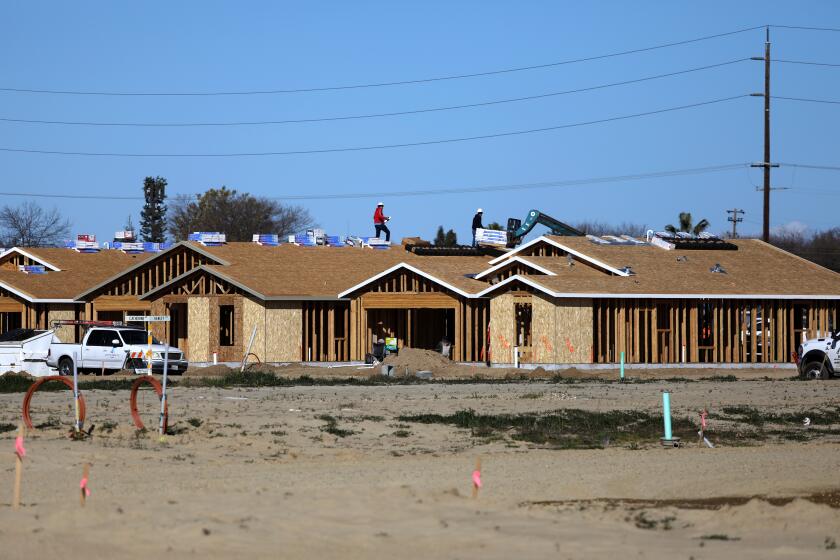The U.S. population is older than ever. What that means

- Share via
The median age in the U.S. has never been higher as declining birthrates, slowing immigration and the steady aging of baby boomers combine to extend a decades-long national maturing.
From 2021 to 2022, the nation’s median age — at which half the population is younger and half is older — increased 0.2 of a year to an all-time high of 38.9 years, according to U.S. Census Bureau population estimates released Thursday.
The country’s median age was 37.8 years for men and 40 years for women.
The U.S. median age increased nearly four years between 2000 and 2022. Over that period, the portion of the national population younger than 18 fell to 21.7% from 26%. Meanwhile, the share of senior-age individuals swelled, from 12% in 2000 to 17.3% in 2022.
“As the nation’s median age creeps closer to 40, you can really see how the aging of baby boomers and now their children — sometimes called echo boomers — is impacting the median age,” Kristie Wilder, a demographer in the Census Bureau’s Population Division, said in a news release.
About a third of the states had a median age older than 40 in 2022, topped by Maine at 44.8 years old. Utah had the lowest, at 31.9.
California’s median age in 2022, 37.8 years, was just below the national level. No states recorded a drop in median age from 2021 to 2022, census figures show.
The median age in the U.S. has been steadily increasing since the 1980s because of changes in birthrate and immigration patterns, according to Andrew Beveridge, a sociologist at Queens College and the City University of New York Graduate School and University Center.
Immigrants tend to move to the U.S. when they’re of younger, child-bearing age and also tend to have more children than the rest of the population, Beveridge said. The slowing of immigration due to restrictions imposed during the Trump administration and the COVID-19 pandemic exacerbated the long-standing trend.
The state’s major cities lost people between 2020 and 2022, especially in Northern California. But exurban boomtowns, including some Southern California areas, saw gains.
The median age could go up even more in the next few years, Beveridge said, as COVID-19 took a disproportionately high toll on older Americans.
Women becoming more educated, entering the workforce in larger numbers and having access to birth control have all also dampened the birthrate and increased the age at which the average U.S. woman gets married and has children, according to Beveridge.
“Women becoming more independent means that they don’t only have to become mothers,” he said. “They marry a lot later. It went up from the early 20s until now it’s approaching 30. If you get married at that age, you’re less likely to have a lot of kids. It really is arithmetic.”
The U.S. is also less “child-friendly” than other Western countries, Beveridge said, citing Italy as an example of a country that covers some of the medical expenses and costs that come with raising a kid to encourage more people to have children.
The U.S. is grappling with high housing costs, college tuition and child care, making some Americans less likely to have kids.
“It would come down to either forcing women to have kids, a la ‘The Handmaid’s Tale,’ or really seriously supporting people to have kids,” Beveridge said. “Once women were able to control their own reproduction, they really could make their own choices. The norm used to be women being less likely to go to college. Now the norm is that women go to college and get a job.”
William Frey, a demographer at the Brookings Institution, said that countries haven’t been very successful at encouraging otherwise hesitant people to have children.
“Even if we pick up fertility, it’s still not gonna be enough to bring up the baby boomer generation because women of a child-bearing age are a smaller proportion of the population,” he said.
Instead, he said, governments can adjust immigration policies as a way to slow the age dependency in their societies and to increase the size and productivity of their working-age population.
“That’s the one safety valve we have moving forward,” Frey said.
A higher median age and shrinking birthrate also mean it will be more difficult for working-age adults to support the aging population through Medicare and Social Security contributions.
California’s population continued to shrink last year, but it built housing at a pace not seen since 2008, according to a state Department of Finance report.
Between 2010 and 2020, the nonworking population increased by 13.1 million people, or 12.9%; while the working-age population grew by only 6.4 million, or 3.1%.
The U.S. Bureau of Labor Statistics estimates that the number of people 75 and older who are still working is expected to grow 96.5% over the next decade.
“If you have more people going into the Social Security fund than people putting in, it really has to come out of the economy,” Frey said. “You either have to raise the amount or subsidize from the general revenue or cut benefits. It has a big effect like that.”
More to Read
Sign up for Essential California
The most important California stories and recommendations in your inbox every morning.
You may occasionally receive promotional content from the Los Angeles Times.

















